I long dreamt of the Arctic, an area so mysterious and remote I knew even before I arrived that a trek to ski here would test my resolve and be the ultimate adventure. The vast expanses of ice, right angles where ocean meets rock, some of the biggest vertical rock faces in the world and equally impressive couloirs are just part of its overwhelming inspiration.
by DAN EVANS from Winter 2016 issue
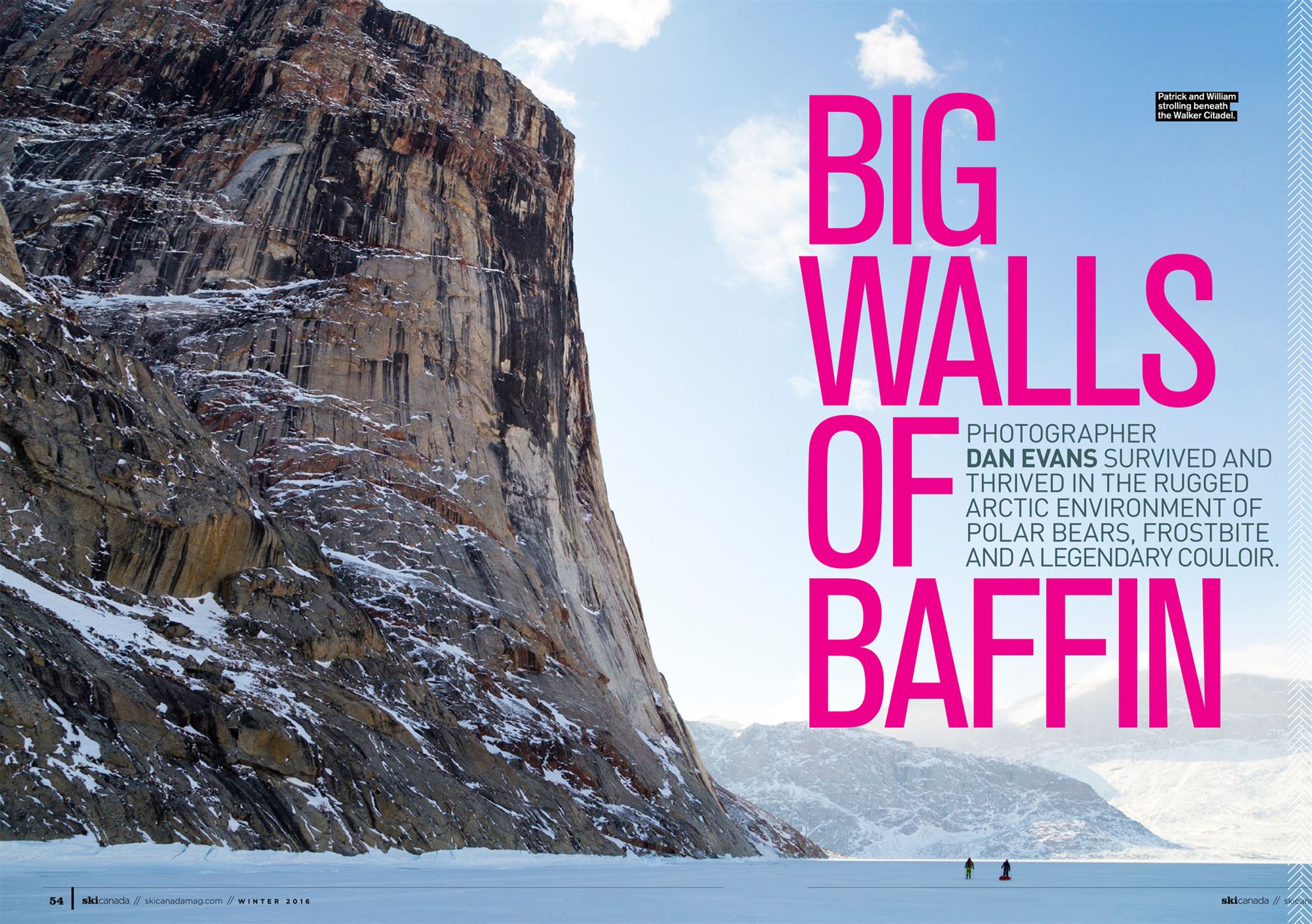
Last April, we landed at the Iqaluit airport, which looks like something imagined by a Star Trek set designer—a yellow bunker with tunnels for entry, hinting that even landing here is a battle. Giving a sense of having truly entered “The North,” the landscape is devoid of trees and the bay full of jagged pack ice. Our first few days were a frigid -27 during the day, but either due to the complete lack of humidity or just my extreme stoke level, it didn’t seem very cold.
Along for the ride with me were three other adventurers: Patrick Bruce and William Hyndman, Iqaluit locals and long-time friends of mine; and fellow Banff skier Michelle Brazier, an experienced ski mountaineer and a standard on Banff missions. As a part-time polar dogsled guide, Willie had the most experience in the group.
Michelle and I spent eight months preparing for the worst-case scenario on this trip, including amassing the right safety gear. Not surprisingly, airlines won’t let you fly with some important gear list items, such as explosives. Finding the last few items forced us to explore the local shopping experience in Iqaluit, Nunavut’s capital. Everything needs to be flown or sailed here to Baffin Island, and that made for some expensive cans of Dr Pepper and essential gummies at the local grocery store, North Mart.
One of the last pieces of kit that we needed brought us to the doorstep of explorer Matty McNair. Matty is the owner of NorthWinds (northwinds-arctic.com), which specializes in polar adventures. She’s travelled to both the North and South Poles (with her kids) via dogsled and kite-ski. In fact, during the time of our trip her daughter was attempting a 25-year anniversary dogsled circumnavigation of Baffin Island, a 4,000-km journey (which ended successfully). Matty’s list of polar expeditions left us in awe, but amazingly, she was one of the most grounded adventurers I’ve yet to meet.
After an invitation for coffee, we learned that Matty, well into her 50s, had slipped on the dogsled that day and possibly had a concussion, but that didn’t stop her from showing us some of her past trips to Sam Ford Fjord. Her quiet strength was inspirational, especially for Michelle, as they instantly bonded as female Arctic adventurers.
*******************************************************************
We set foot in Sam Ford Fjord after four hours in a qamutik (kom-ah-tik), an Inuit hauling-sled. Our beautiful sea-ice camp in Swiss Bay was sheltered from the wind and located at a crossroads directly in front of an impressive glacier terminus and central to our couloir objectives. We soon discovered that being “central” to everything actually meant three hours from anything. At our first glimpse of the regal Polar Sun Spire, it started to sink in how large a 1,300m cliff face is. Any one of these walls would be impressive alone, but there are dozens of walls in Sam Ford stacked side by side, carved by unfathomable glaciers.
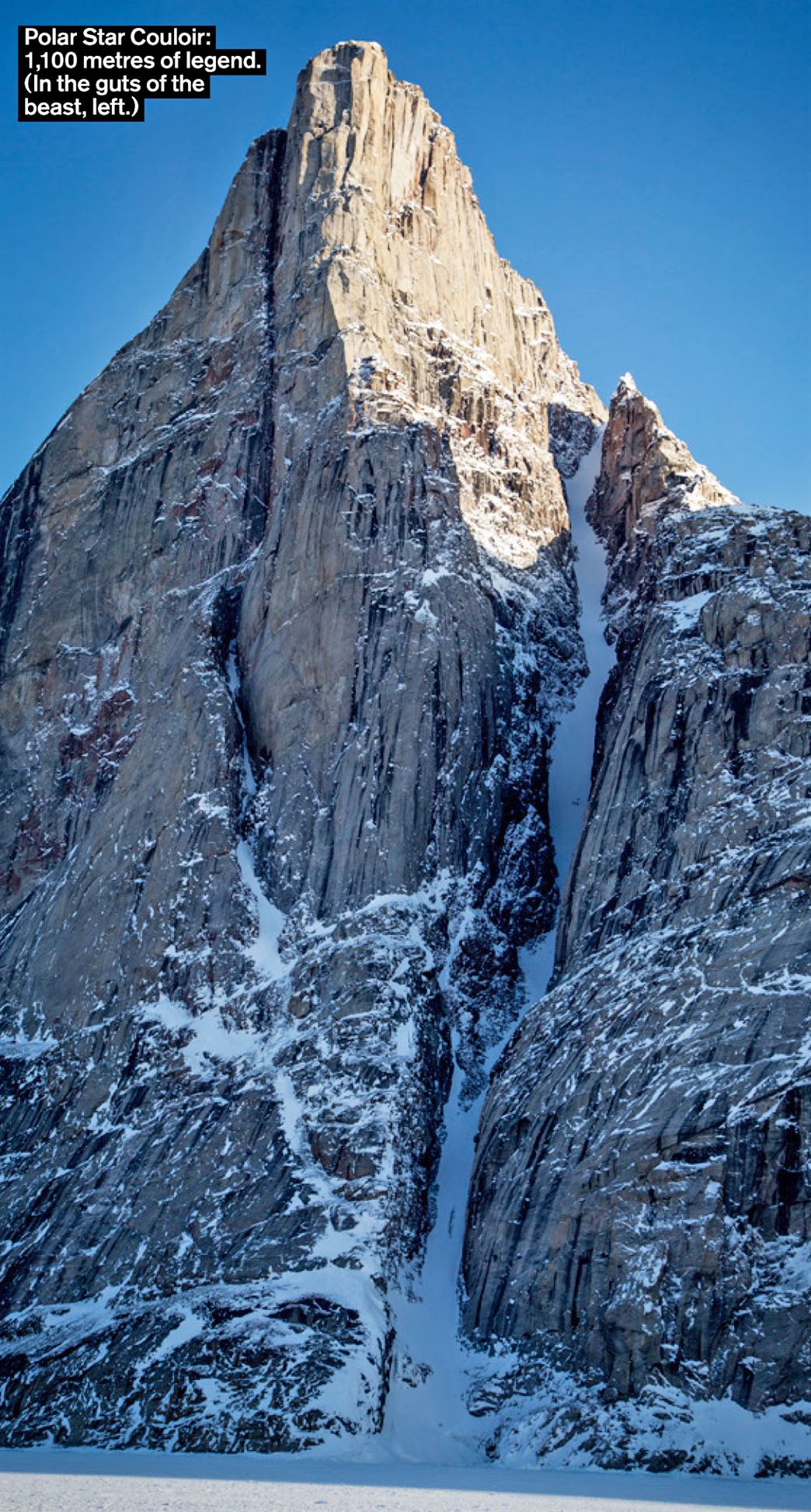
The remoteness of the area revealed itself as I stood a few steps away from camp and heard…nothing. The silence was so complete that it felt tangible, as if you could reach out and touch it. At times it was contrasted by a roaring avalanche from a serac fall (glacier ice chunk) or a deafening wind that threatened to break our tent poles. One such wind lasted more than 24 hours. It was like trying to go about your day with a train constantly passing beside your head. We yelled at each other to be heard over the flapping tent fabric.
Daytime temperatures floated around -25 for our first few days. Cold was certainly one of our biggest considerations for the trip. Despite the cold, the weather couldn’t have been better as we sat in a beautiful Arctic high for the majority of our 16 days on the land. In our entire time in the Sam Ford area we saw less than a full day’s worth of clouds. The wind did its best to blow us around and keep us guessing at the most unexpected moments.
*********************************************************************
Patrick and Willie are both experienced kite-skiers and brought along a kite for each of us. This made our planned Fjord crossings always a toss-up between walking our kit or setting up a kite with the hopes our journey would be wind-powered. On one particularly windy day, all four of us set up our kites only to have the wind co-operate for precisely a minute’s worth of skiing and then die for more than an hour. It was just hard to predict.
When the winds started up again, it was unreal to skim along the frozen Fjord under gargantuan cliff faces like the Walker Citadel, a castle of a mountain that stands at a 270-degree guard on the corner of the Walker Arm and Stewart Valley.
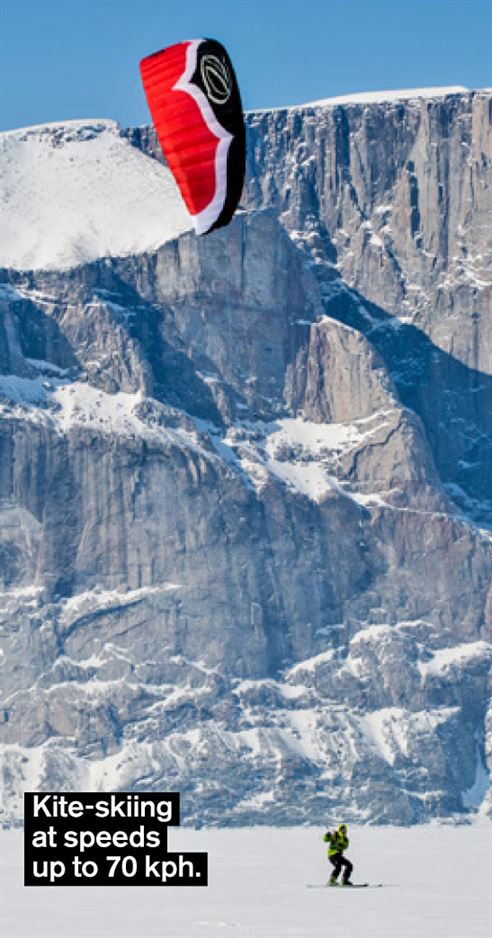
We didn’t travel more than 3,000 km to Baffin Island for just the allure of wind. Our original pull came from the legendary book, Fifty Classic Descents of North America, and a guidebook that described the Polar Star Couloir as “possibly the best skiing couloir on the planet.” At more than a vertical kilometre and 45-50 degrees straight down to the ocean, this line has teased my dreams since I first read about it.
Michelle and I both agreed we couldn’t go straight for it, so we decided to do a couple of warm-up runs of 600-800m couloirs. The first and closest descent to camp in Swiss Bay was a good warm-up of 650m-plus to a beautiful col. The first bootpack of many would take us 2.5 hours, fairly quick travel for a climb that size. Sporty would be a good way to describe the skiing on this one since it got Michelle and me back into downhill mode, arcing cautious turns down a gorgeous, albeit chalky, run. The snow penetration on the way down was minimal but not icy, and every time I gained a bit more speed than I should, my skis (and teeth) felt as if they would chatter right off me. Down at the sea ice, Michelle asked, “Do you think they’ll all ski like this?”
On that first day kicking steps, my toes entered serious frozen territory. Several of my toes ballooned with blisters and felt like a hot knife was lancing my toenails. With alternating waves of stubbornness and realism, the thought crossed my mind more than once that my journey may be over on only day four. I managed to keep going with a combination of chemical heat packs during the day and thorough boot drying at night.
While days were spent sampling 600-1,000m couloirs, the evenings were spent huddled in our tent. The amazing part of travelling by sled is that camping becomes, according to Willie, “less about volume and more about comfort.” This afforded us extra luxuries such as a dedicated tent for cooking and a stovetop Italian espresso maker. This tent became our refuge after big days of climbing, and a chance to dry all our sweaty clothes. We ate like kings, with amazing food ranging from lamb stew to shepherd’s pie prepared by Yamnuska Backcountry Kitchen.
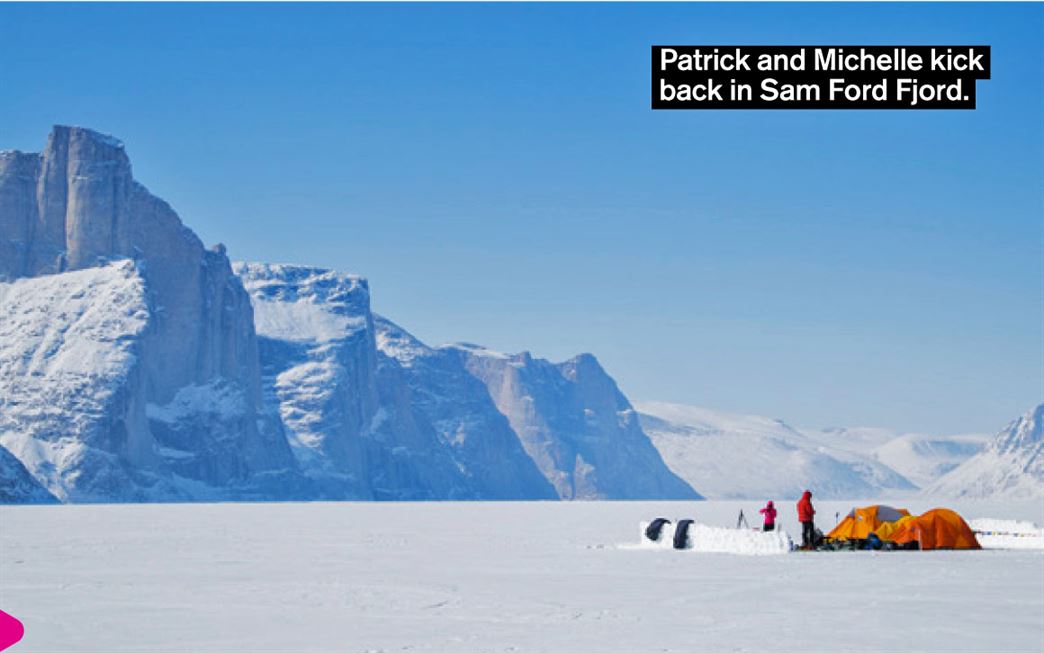
We stayed at the Ford Wall for four nights and skied some beauty lines, but then it was time to go for the Polar Star Couloir. However, we had a visitor to deal with first.
One night early on, I awoke certain I was hearing the sound of a bear growling and moving around just outside the tent. I was absolutely sure this would be the moment of truth and a surge of fear and adrenalin hit me. I sat up and grabbed the flares, ready to defend my life, only to realize the bear was actually Patrick snoring.
It wasn’t until moving day that we came face-to-face with the great mascot of the north. Out of nowhere, a polar bear cub wandered out of the pack ice only 100m from camp. Of course, with cubs come an angry mother. My first thoughts turned to survival: bear equals life-threatening situation. “I’ll get the bangers. Pat, is the gun loaded?” I asked warily. He replied in the affirmative and we kept our eyes locked on our visitor. The cub started to circle and sniff our camp, working its way cautiously closer. Since it was so young, I’m sure it had no fear of us; this was probably its first human contact. To keep the young bear at bay, I loaded up our bear bangers and let loose. The first shot cascaded in a perfect arc right toward the cub. Crack!
The bear ran for its life after the sonic boom that felt as if it shook the nearest peak. The funny thing about being in a wide-open space for kilometres in any direction is that you can run for a long time without getting anywhere. The bear ran for about a minute into the Fjord, and then turned around when it likely realized it wasn’t injured. Fortunately, more of the boom sticks were at the ready, and the second shot had the bear sprinting into the safety of the pack ice.
The bear’s departure was a golden opportunity to escape. It was camp moving day, after all, and the Polar Star Couloir was calling. After we’d walked a few kilometres, the animal decided we weren’t going to come back and worked its way over to our campsite to inspect the kitchen tent “sewer.” Although not a great amount of calories was left there, we did wonder how wired that poor creature was after four days’ worth of coffee grinds.
*************************************************************************
The main objective of the trip was now in sight: the Polar Star Couloir. We decided to take a chance setting up camp at the foot of the line in the unprotected middle of the Fjord. During dinner that night, a serac calved off the neighbouring glacier, giving us a somewhat ominous reminder of what could be the following morning.
Once we took the obligatory selfies at the bottom, it was time to kick thousands of steps to the top of Sam Ford’s prize. All went normal for the first three hours and 700m among the vertical walls that dwarfed us as we climbed. Above 700m, however, it was deeper and steeper, until the grade hit north of 45 degrees. Travel at this point became like a wolverine crawl more than a bootpack, as I used elbows, knees and any body part that would help continue the upward progress.
In the triumphant moment of topping out, I was overwhelmed with emotion and happy tears started to flow. The reward for the climb was a bird’s-eye view of another enormous glacier. Once Michelle joined me at the top a few minutes later, all she could muster in between her laboured breathing was: “That was hard.” Standing at the top, it started to sink in that very few people in the world had ever been in this spot. Indeed, first descents only happened in 2002 by Brad Barlage and Andrew McLean. In all the research we could find on our return, Michelle appears to be the only Canadian woman to reach the col of Polar Star Couloir.
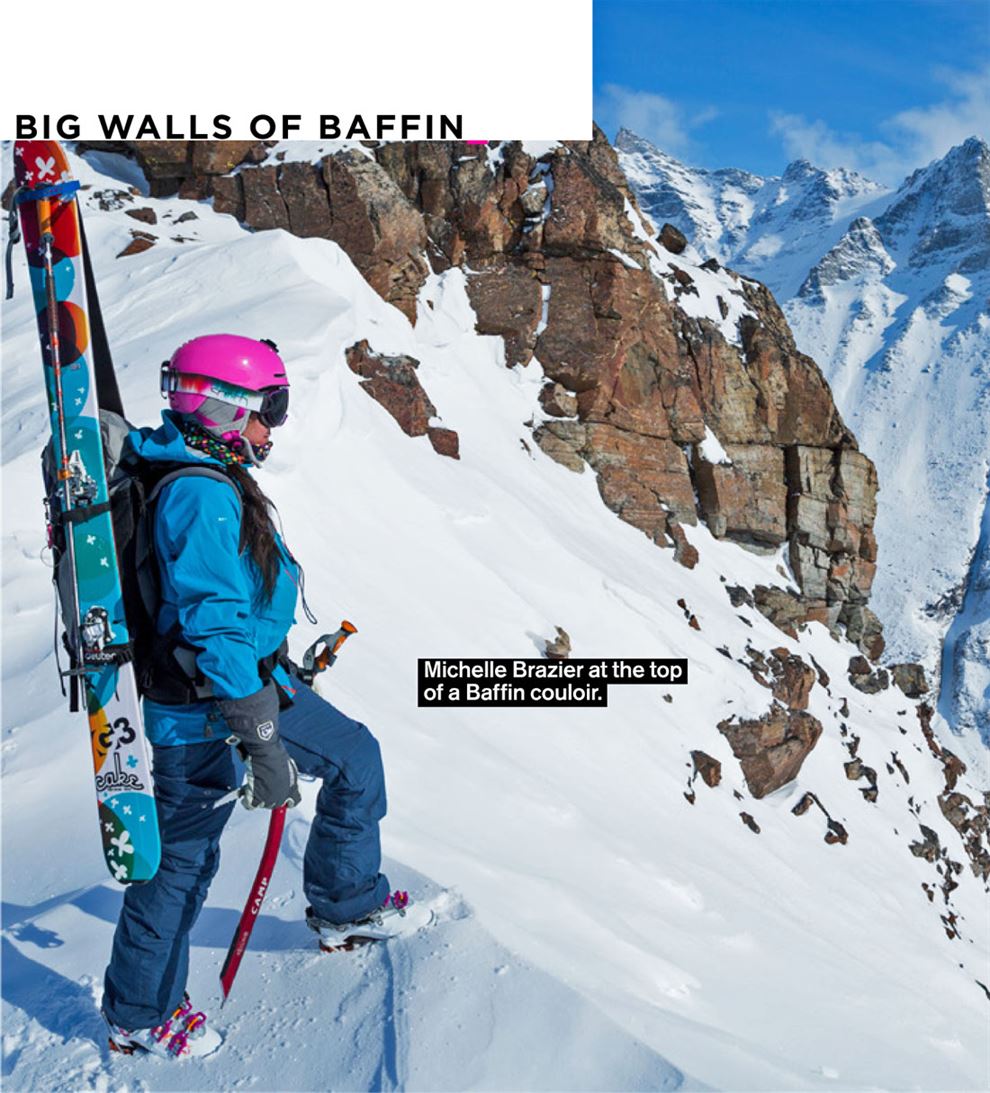
The ski down was by far the best one of our journey to the Arctic. It started with an intimidating look down 1,100m to the frozen ocean below. I kept reminding Michelle, mostly for my own benefit, that this was just another ski run. I would be lying if I said my heart wasn’t pumping hard for the first few turns. Amazingly, the combination of geology and aspect made for some unreal powder. Every turn started a race of beautiful slough that teased at my skis. Our slough travelled all the way to the sea ice, with us keeping the entire vertical kilometre soft. The only sounds that could be heard were the shushing of the snow and my occasional involuntary screams of joy. It was a victory lap from top to bottom that I’ll never forget.
*********************************************************************
Some days later, when we were picked up from the Fjord and taken back to civilization, I counted at least a dozen more couloirs. Our days on the ice had hardly put a dent in the potential for the area, but left a permanent stamp on my life. The vastness of this remarkable polar playground is unbelievable, and hopefully its remoteness will keep it pristine for centuries to come.
This was by far the biggest adventure that I could ever have dreamt of. Michelle and I, two fairly green adventurers, had a vision and somehow transformed it into the line of a lifetime in the Canadian Arctic.
NUNAVUT NUMBERS
- 300-700 kg, male polar bear
- 43 kg, Michelle Brazier
- 8 bear bangers
- 20 6.5×55 SE bullets
- 1 rifle possibly used in WWII
- Area of Nunavut: 1,900,000 km2
- Baffin Island: world’s 5th largest island
- Population of Nunavut: 33,330
- Area of Baffin Island: 507,451 km2
- 65 sq km per person in Nunavut
- No. of people per sq km in Nunavut: 0.015
- No. of people per sq km in Canada: 3.5
- No. of people per sq km in Toronto: 4,149
- No. of seals in NW Atlantic: 7.4 million
- Cost of a case of pop in Iqaluit: $16
- Cost of a 10-lb Arctic Char: $20
- Number of cellphones in Clyde River: 0
- No. of flights to Sam Ford Fjord from Western Canada: 3
- Kms left to go with a snow machine: 100
- Distance from Calgary to Clyde River, NU: 3,081 km
Special thanks to MEC, Helly Hansen, Yamnuska Backcountry Kitchen and the Alpine Club of Canada. This expedition was made possible by a grant from the Jen Higgins Fund of the ACC.